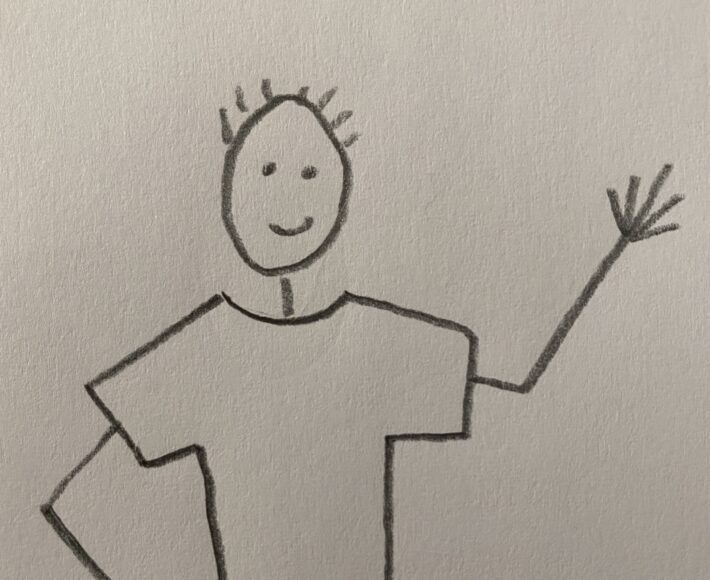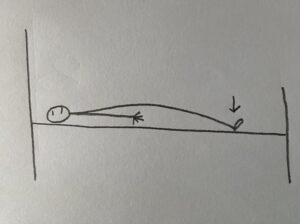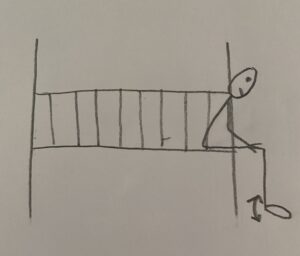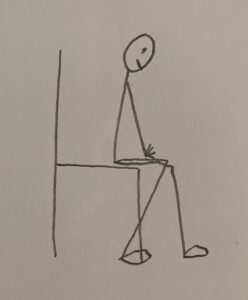We have our exercise programs. Lift weights. Aerobics. Yoga class. They consume large chunks of time in our day, and require planning to complete. But here are 5 simple exercises which require almost no extra time to complete, and you achieve important long-term benefits to boot.
Don’t wait to start having symptoms, and then start doing the exercises. Start when you’re 40-years-old, or as soon as you read this!
Now, I wish this could go without saying, but if you experience a lot of pain when you do these exercises, then don’t do them anymore…and go see a real doctor…or one who hasn’t retired.
Morning Back Stretch
Despite not really having back problems, my back feels stiff when I get up in the morning. One of my patients told me about his daily morning stretch, and how it eliminated that ache. It sounded too simple to be effective, but I gave it a try, and now I do it every morning. I can feel the stiffness resolve within moments.
While lying flat on your back, face up, gently press your heels into the mattress. You don’t have to actively stretch your back. It will simply happen as you press those heels down. At first you might feel a tad of discomfort, but that quickly resolves as your back slightly extends. I do it a couple of times. Boomshakalaka. I’m almost ready to jump out of bed…except for there’s exercise #2.
Morning Foot Stretch
As we age, that first step we take in the morning can be a painful one, and for many women especially, can actually result in the onset of plantar fasciitis or Achilles tendonitis, as these contracted structures acutely and forcibly stretch when we put our feet down, and add our body weight on top. This can tear the stiff tendons and result in chronic damage, especially if you do it the next morning…and the next.
Don’t wait to sustain injury. Start now.
Swing your legs around (after you did that morning back stretch), and set your feet on the ground, without applying all your weight to them. Then press them up and down, applying only part of your weight on your feet, kind of like a kitty kneads the ground with its paws. As you can sense that the bottom of your foot is okay, and there’s no pain, then gradually increase your weight, until you’re able to stand up without discomfort. For those of you who have no issues, this will only take a few seconds. If you feel a stretchy discomfort, or even acute pain, back off the weight you’ve applied and keep stretching. You can also do this stretch if you’ve been driving or sitting for a long time.
Single-leg Standing (SLS)
SLS is an exercise proven to prevent falls, and thereby prevent fragility fractures in those of us of a certain golden age!
Simply stand on one leg, and get to the point where you can do that for 30 seconds…longer if you wish. And less, if 30 seconds causes pain in a weight-bearing joint, such as the knee. Start out someplace like your kitchen, where there is a countertop to use for support, and you can get conditioned to just standing on one leg. Then stand on one of your legs, and intermittently remove your hand from the counter. Eventually you will be able to remove your hand, and stand on the one leg for longer and longer periods of time, as you develop your balance. This might take weeks to even a few months, as you may be de-conditioned to standing on one leg, never mind standing on one leg with no additional support from your hand on the countertop. Eventually, you will be able to stand on either leg…no hands…for 30 seconds! You can do this intermittently during the day, like when you’re cooking, brushing your teeth, standing in an elevator or on a line! You don’t have to take time out to do SLS! Embrace the multitasking.
Knee Extension
Those of us who are susceptible to developing arthritis in the knees or hips, will begin to get stiff as we age. It happens insidiously. It’s kind of natural for the arthritic knee to begin to stay bent, as a way of limiting pain, or as compensation for a stiff hip or ankle. You might develop a habit of resting with it in a bent position. It stays bent all night. It feels better that way! And suddenly, you realize that it’s stuck. You can no longer straighten it all the way. You now have a contracture, and it’s usually permanent. This in turn causes a bent-knee gait…or a limp. But you don’t have to end up like this, even if you have arthritis.
Every day, at any time, when you’re sitting down, straighten your leg out all the way. It’s hard to judge straightness by just standing with it straight, or sticking it out in front of you. Make the knee like a bridge. Put your heel on the ground, on a coffee table, or a chair, and let that knee completely go straight. You can even press your thigh, just above the knee to help it along. Then contract your quadriceps muscle, in order to hold it there. If you’ve developed arthritis, this could be a little uncomfortable. So, do it gently. If you just did this once a day, starting before you get that contracture, it could prevent it completely. After you already have a contracture, you can try to straighten it, but will likely need help from a physical therapist.
Sitting heel stretch
With age, deconditioning or diminished exercise, our Achilles tendon might begin to shorten. This is particularly prevalent in women, because we’re shorter and more likely to sit with our foot pointed down and our Achilles tendon shortened. We’re also more likely to sit with our feet tucked up under us, also resulting in a shortened Achilles tendon. Wearing high heels can have the same effect. This can become chronic and in turn lead to painful mechanical problems with our feet and ankles. So, at some point every day, starting when you read this, spend some time during the day with your feet flat on the ground, and even better, with your ankle resting behind the line of your knee, so that there is some stretching of your Achilles tendon. It kind of goes along with my Sit Like A Man (S.L.A.M.) concept.
Start these simple exercises sooner than later, so you’re not behind the eight ball, and working to correct problems rather than to prevent them.
I did the artwork myself! Been thinking of a new career. If you’re interested in custom medical illustration, don’t hesitate to contact me…






Janet Hewlett
Awesome!
Barbara
Thanks Janet! Give them a try and see how you do!
Pam Clements
thanks! adding all of these to my daily routine!
Barbara
Thumbs up. I’ll keep blogging and hopefully sending more helpful stuff!
Alfreda
Thank you Dr Bergin. I’m 68 and have Arthritis in my knees and both hips bursitis. If I’d only known earlier what I know now I might not be in so much pain. I’m going to start with these exercises and I’m sure I’ll get some relief. xx
Barbara
It’s never too late!
Pam Hinton
Definitely need to talk to you about some custom art work.
Barbara
Haha! Maybe next weekend?
Margaret Virr
Great, common sense easy exercises! Thanks
Barbara
I’m doing one of them right now! Thanks for reading my blog posts!
Kalí Rourke
These are great! I am adding them to my regular stretches and thanks for sharing them!
Kalí Rourke
These are great! I am adding them to my regular stretches and thanks for sharing them!
Yolanda
Thanks!! Where all are very good, I saw 2 that will real help.
Barbara
Good! Do them all!
Terri Ward
Thanks for the tips!
Barbara
You’re welcome. Keep watching for new posts!
Roberta Mankowski
Keep it up ?. I really appreciate your shared insight!
Barbara
I need to be better! Will try. Still got a lot to teach! Thanks for following me!
Judith
Always so helpful!
Barbara
Thank you!
Annette Parkhurst
I have two new knees (March 22 & June 8)! Well, I O course wish you had been my surgeon, you left me in Fantabulous hands! According to the good doctor, my knees, with the worst he’s ever seen! Especially the second (the right). These are my stable of exercises and man they do a good job! I suspect they are mine for the rest of my life, but that’s OK! Hope you are well and enjoying your new digs and new life! Sending you hugs. Annette P
Barbara
I’m so glad you finally got those knees done. You hung on for a LONG time! No wonder they were so bad! Good health to you!
Charlotte A Barbini
I have RA and it takes about an hour to work out the “kinks”. Stretching and movement really helps. My exercise program is grabbing a cart and walking every aisle at whatever store has air conditioning. Compliments on the art work!
Barbara
I’ll try to be more consistent, for everyone’s benefit! Take care!
Jann Alexander
Always appreciate your tips! Next best thing to seeing you in your practice. Thanks.
Barbara
Thanks Jann! Miss all of you too! I’ll try to blog more often!
Jay Drayer
Might you please do a post of suggestions for stiffening shoulders?
Barbara
Yes I will! The next one is on foot numbness, but after that I’ll tackle shoulder stiffness! If I forget and do something else…remind me!
Janis fritsch
Love your email newsletters. always informative and humorous! sure miss you but hope you are loving your retirement! i got my left knee replaced 1 year ago and so much better! I do exercise everyday and it has always helped. Keep sending your suggestions and advice!
Barbara
Janis, Good to hear from you and glad you’re doing well after getting your knee replaced. Thanks for following my blog!
Andy & Faye Hays
What can causes numbness in toes on right foot, sure miss seeing you Andy and Faye Hays.
Barbara
My next blog post might shed some light on toe numbness! Lots of potential causes.
Karen Anderson
Thanks Barbara .. I’ll add the ones I’m not doing !! They are good ones and easy !! Love your blogs..?
Barbara
Thanks for keeping up Karen! Hope they help. New blog post coming soon!